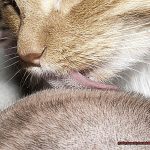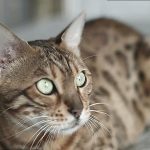Do you long for a furry feline friend but can’t seem to shake off those pesky cat allergies? Or perhaps someone close to your heart suffers from the same fate, and you’ve given up on the idea of ever owning a cat. Fear not, my friends. The solution lies in hypoallergenic cat breeds.
But before we reveal which breed is the most hypoallergenic, let’s get one thing straight. Hypoallergenic doesn’t mean allergen-free. It means that these breeds produce fewer allergens than others, making them a viable option for those with allergies.
Now, onto the juicy stuff. You’re probably wondering which breed made it to the top of our list. But here’s the twist – there isn’t just one. There are several hypoallergenic cat breeds out there, each with its own unique qualities that make them stand out from the rest.
In this blog post, we’ll introduce you to some of the most adorable and fluffy hypoallergenic cats in the world. We’ll explore what makes them special and why they might be an excellent fit for you and your family. So sit tight and get ready to fall in love with these cute kitties.
Factors Influencing Allergen Levels in Cats
While certain breeds may be recommended as “hypoallergenic,” it’s crucial to understand that there are multiple factors that contribute to allergen production in cats.
Genetics play a significant role in allergen production, with some breeds being selectively bred for low allergen production, such as the Siberian, Balinese, and Devon Rex breeds. However, even within these breeds, individual cats may produce higher levels of allergens.
Gender is also an important factor to consider. Male cats produce more allergens than females because of their higher levels of testosterone, which stimulates the sebaceous glands to produce more allergens.
The age of the cat can also impact allergen levels. Younger cats tend to produce fewer allergens than older cats because their sebaceous glands become more active as they age.
Diet can also influence allergen production, with cats on high-fat diets tending to produce more allergens than those on low-fat diets due to fatty acids stimulating the sebaceous glands.
Environmental factors can also affect allergen levels in cats. Regular grooming and bathing can help reduce the amount of allergens on a cat’s fur, while exposure to cigarette smoke and pollutants can increase allergen levels.
Commonly Recommended Hypoallergenic Cat Breeds
As an expert on commonly recommended hypoallergenic cat breeds, I can tell you that there are several options to consider.
First on the list is the Siberian cat. These fluffy felines produce less of the Fel d 1 protein, which causes allergic reactions in humans. Additionally, some allergy sufferers have reported milder symptoms when interacting with Siberian cats compared to other breeds. This makes them a popular choice for those looking for a hypoallergenic cat.
Another recommended breed is the Sphynx. These hairless cats shed less dander and fur, which means fewer allergens in your home. However, some people may still experience allergies due to the Sphynx’s skin oils and saliva. Despite this, they remain a popular choice for those with allergies.
If you’re looking for a unique-looking cat, consider the Devon Rex. Their curly coat sheds very little and they produce less dander than other breeds. Plus, their playful and affectionate personalities make them great companions. They are perfect for those who want an active and sociable pet.
Other hypoallergenic cat breeds to consider include the Cornish Rex, Balinese, and Oriental Shorthair. Each of these breeds produces fewer allergens than other cats, making them a good fit for allergy sufferers. These cats are known for their intelligence, loyalty, and affectionate nature.
Although these breeds are considered hypoallergenic, it’s important to note that everyone’s allergies are different. Spending time with a cat before bringing them home can help you determine if you’re allergic to that particular breed. In addition to this, regular grooming and cleaning can also help reduce allergens in your home.
Variation Among Hypoallergenic Breeds
Hypoallergenic breeds do exist, but not all of them are created equal. Let’s explore the variations among these breeds and the factors that can influence their hypoallergenicity.
First up, we have the Siberian cat. This breed is often considered hypoallergenic because of their lower levels of the Fel d 1 protein in their saliva and skin. However, not all Siberians have reduced levels of this protein, so it’s important to spend time with a specific cat before bringing them home. Don’t let your allergies ruin your chances of bonding with these lovable cats.
Next on our list is the Sphynx breed. These hairless cats are often thought of as being hypoallergenic due to their lack of fur. However, they can still produce allergens through their skin oils. In addition, some people may have an allergic reaction to the Sphynx’s saliva or urine. While they may not be the best choice for those with severe allergies, regular grooming can help reduce allergens in your home.
The Devon Rex and Cornish Rex breeds are also considered to be hypoallergenic due to their minimal shedding and lower levels of Fel d 1 protein. However, as with Siberians, individual cats may vary in their hypoallergenicity. It’s essential to spend quality time with a specific cat before making a commitment.
Diet, Grooming Habits, and Environment Affecting Allergen Production
However, there is hope. By tweaking their diet, grooming habits, and environment, you can reduce allergen production in cats.
Let’s start with diet. Just like humans, a cat’s food affects their skin and coat health. Foods high in fatty acids, particularly omega-3s, can maintain healthy skin and reduce shedding. This ultimately leads to less dander production and fewer allergens in the air. The next time you’re at the pet store, choose a food that contains these beneficial fatty acids.
Grooming habits are another vital factor to consider when reducing allergens in cats. Regular grooming and bathing remove loose hair and dead skin cells, which significantly contribute to dander production. Brushing your cat once or twice a week is an excellent way to reduce the number of allergens in the air. It also provides an opportunity for bonding with your feline companion.
The environment in which your cat lives has a significant impact on allergen production. Keeping a clean home with low humidity levels is critical. Regular dusting and vacuuming help eliminate any allergens that may have settled on surfaces. You may also want to invest in an air purifier with a HEPA filter to trap any remaining allergens before they become airborne.
It is important to note that even hypoallergenic cat breeds produce some degree of allergens, so there is no such thing as a completely hypoallergenic cat. It’s always best to spend time around individual cats before adopting to gauge your reaction and determine if you can tolerate their allergen levels.
The Most Hypoallergenic Cat Breeds: Sphynx, Devon Rex, and Cornish Rex
There are cat breeds that produce fewer allergens than others, which makes them a great option for allergy sufferers. Among these breeds, the Sphynx, Devon Rex, and Cornish Rex are often considered the top choices.
Let’s start with the unique and hairless Sphynx. This breed produces minimal dander – the primary culprit behind cat allergies. Though they still produce some allergens through their saliva and skin oils, their lack of fur makes them an instant favorite for allergy sufferers. Plus, without all that fur to shed, there’s less mess to clean up.
Moving on to the curly-coated Devon Rex and Cornish Rex breeds – their wavy fur traps allergens close to their skin, which means they shed less and produce less dander than other breeds. Additionally, both breeds have lower levels of the protein Fel d 1 in their saliva – another common allergen in cats.
But before you run out and adopt one of these hypoallergenic kitties, it’s essential to note that no cat breed is completely allergen-free. Individuals can have different levels of sensitivity to allergens, so it’s always a good idea to spend time around a specific breed before committing to bringing one into your home.
Reducing allergen production in cats requires effort and commitment. By tweaking their diet, grooming habits, and environment, you can ensure everyone in your home can enjoy the company of these adorable felines without any allergy-related issues.
Pros and Cons of Owning a Hypoallergenic Cat
The solution you’ve been waiting for may be a hypoallergenic cat. While there are benefits to owning one of these rare breeds, there are also some drawbacks to consider.
The benefits of owning a hypoallergenic cat are numerous. These cats produce less dander, making them ideal for people with allergies or asthma. You can enjoy the company of a feline friend without experiencing the dreaded itching and sneezing. In addition, hypoallergenic cats shed less hair and dander, which means that grooming requires less time and money compared to regular cats.
However, there are some potential drawbacks to owning a hypoallergenic cat. The most obvious barrier is the cost. Due to their rarity, these cats can be more expensive to purchase than other breeds. Additionally, while they produce less dander, allergens can still be present in their saliva or urine, which may cause some allergic reactions. Some hypoallergenic breeds may require more grooming than others, which can be time-consuming and costly.
It’s important to note that hypoallergenic cats are not immune to other health issues that regular cats may experience. They still need regular vet checkups, vaccinations, and proper nutrition to maintain their health and well-being.

Adopting a Hypoallergenic Cat
Adopting a hypoallergenic cat might be just what you need. While no cat is completely hypoallergenic, certain breeds are known to produce less of the protein that triggers allergic reactions in humans.
Choosing the right breed is key when it comes to adopting a hypoallergenic cat. Popular breeds like the Siberian, Sphynx, Devon Rex, and Balinese have been known to produce less of the allergen protein Fel d 1, making them great options for people with allergies. These breeds are also less likely to cause severe allergic reactions, meaning you can enjoy their company without having to suffer from unpleasant symptoms.
Of course, as with any pet, adopting a hypoallergenic cat comes with responsibilities. You will need to provide proper veterinary care, nutrition, and lots of love and attention. It’s important to make sure everyone in your household is on board with the decision to adopt a cat, especially if anyone suffers from allergies.
Grooming and cleaning play a significant role in reducing allergens in your home. Regular brushing and bathing of your hypoallergenic cat can help reduce the amount of dander and saliva on their fur, which in turn can help reduce allergic reactions. Additionally, vacuuming and dusting frequently can help keep allergens at bay.
One of the best things about adopting a hypoallergenic cat is the reduced grooming time and costs. They shed less hair and dander, making them ideal for those with allergies or asthma. However, it’s important to remember that they still require proper care and attention to maintain their health and well-being.
Tips for Minimizing Allergens in Your Home
If you have cat allergies, it’s important to take steps to reduce allergens in your home. Not only can allergens cause uncomfortable symptoms such as sneezing and itching, but they can also trigger asthma attacks in some individuals. Here are five reasons why it’s important to minimize allergens if you have cat allergies:
Reduce symptom severity
By minimizing the amount of allergens in your home, you can reduce the severity of your allergy symptoms. This can make a big difference in your quality of life and allow you to enjoy spending time with your cat.
Improve air quality
Allergens can impact the air quality in your home, making it difficult to breathe for those with respiratory issues. By using air filters and cleaning regularly, you can improve the air quality and create a healthier environment.
Prevent cross-contamination
If you have cat allergies, it’s important to prevent cross-contamination by keeping your cat’s hair and dander from spreading throughout your home. By creating cat-free zones and practicing good hygiene, you can minimize the risk of allergen exposure.
Avoid medication dependence
Some people with cat allergies rely on medication to manage their symptoms. By minimizing allergens in your home, you may be able to reduce your dependence on medication and avoid potential side effects.
Enjoy time with your cat
Perhaps the most important reason to minimize allergens if you have cat allergies is to be able to spend time with your feline friend without discomfort or health risks. By taking steps to reduce allergens, you can enjoy a happy and healthy relationship with your furry companion.
Conclusion
In conclusion, hypoallergenic cat breeds offer a solution for allergy sufferers who crave the companionship of a feline friend. While it’s impossible to find an allergen-free cat, certain breeds produce fewer allergens than others.
Genetics, gender, age, diet and environment all play a role in allergen production in cats. However, with proper care and grooming habits, you can reduce the amount of allergens present in your home.
The Siberian, Sphynx, Devon Rex and Cornish Rex are just a few of the recommended hypoallergenic cat breeds. Each breed has its own unique qualities that make them stand out from the rest.
Adopting a hypoallergenic cat requires proper care and attention to maintain their health and well-being. Regular grooming and cleaning can significantly reduce allergens in your home.
By taking steps to minimize allergens in your home through adopting a hypoallergenic cat, you can improve air quality, prevent cross-contamination and avoid medication dependence.







